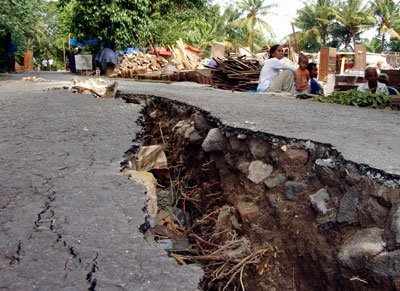GNS Scientists comment on yesterday’s earthquake activity near Vanuatu, whether the earthquakes are in any way linked to last week’s quakes near Samoa and Sumatra and the ever-present threat of a high magnitude quake hitting closer to home…
Dr Warwick Smith, Seismologist at GNS Science, comments:
 “My opinion is that these events are too far apart to be related. We know quite a lot about how when one large earthquake occurs, relieving stress in the Earth, it can either relieve or increase stress on adjoining faults, depending on the geometry.
“My opinion is that these events are too far apart to be related. We know quite a lot about how when one large earthquake occurs, relieving stress in the Earth, it can either relieve or increase stress on adjoining faults, depending on the geometry.
“But that is only for faults in the immediate vicinity, such as the Anatolian fault in Turkey. I don’t believe these stresses can be transmitted over the thousands of kilometres between such places as Samoa, Vanuatu and Indonesia. So I regard these as random coincidences, all evidence of the very active plate margins they are on.
“Three quarters of the world’s earthquakes occur around the rim of the Pacific Ocean. All countries around this rim are wise to have response plans ready, and exercised, at all times.”
Dr John Ristau, Seismologist at GNS Science, comments:
“New Zealand sits astride the boundary of the Australia and Pacific tectonic plates, similar to places such as Samoa and Vanuatu, and the threat of a damaging quake is ever-present. New Zealand has had a bit of a dream run for the past five decades – a remarkably low number of large damaging quakes for a country that has similar earthquake activity to California.
“On average, New Zealand can expect at least one magnitude 7 quake every decade and a magnitude 8 quake every century. The motion along the plate boundary being transferred into New Zealand rocks is about 40mm a year. Over time this builds up enormous stresses that are relieved in earthquakes. It’s worth noting that about 70 percent of the world’s earthquakes occur around the edges of the Pacific Plate.
“Being an island country, New Zealand is also vulnerable to tsunamis from distant and nearby undersea earthquakes and undersea landslides. In the case of distant earthquakes, there is time to evaluate the threat and take appropriate action (such as the threat to NZ from the Samoan
tsunami).
“However, for a tsunami generated just off the New Zealand coast, there will be very little time to issue a warning. People need to learn the warning signs that a tsunami may be arriving and know where to go to be safe.”